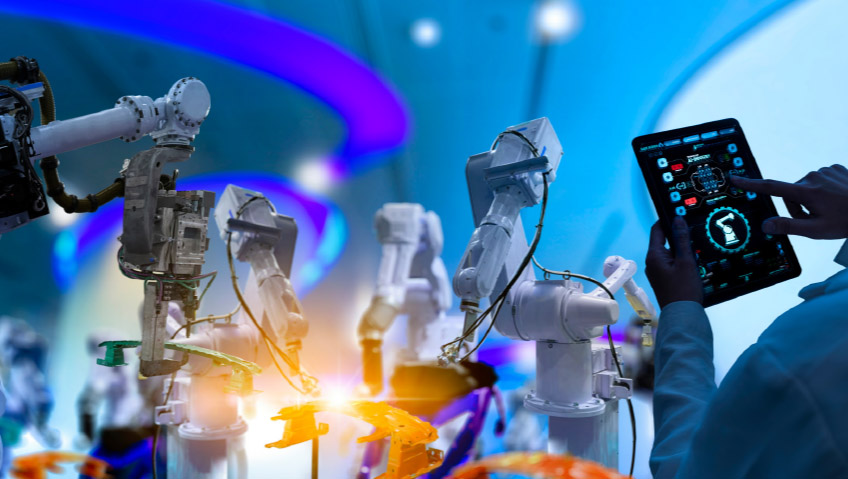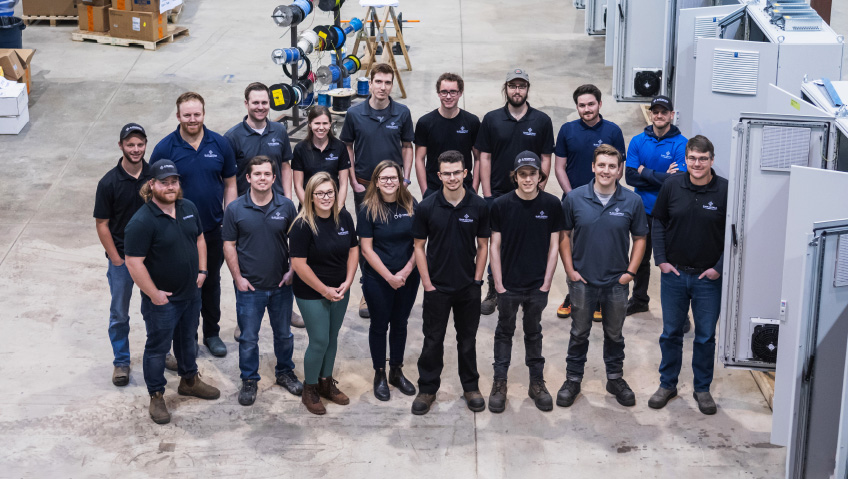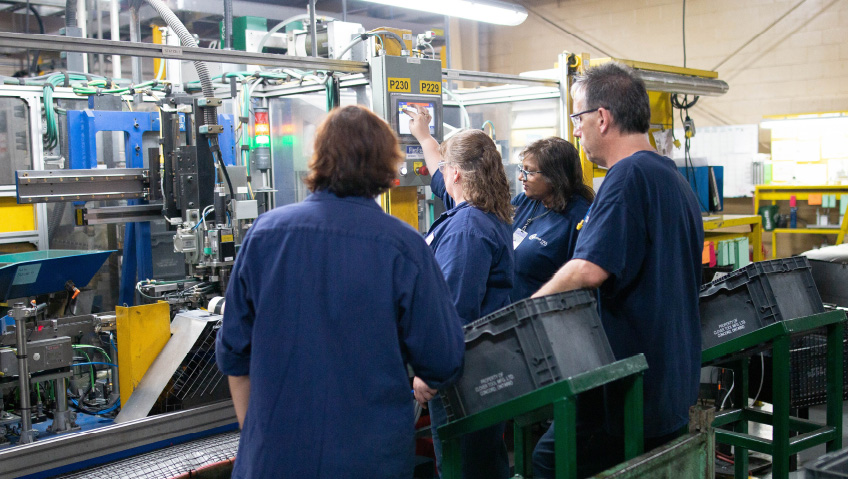Pundits love to use the term Industry 4.0 to describe the future of manufacturing. But what does the term really mean, and how will the tenets of Industry 4.0 impact day-to-day manufacturing operations?
Industry 4.0 stands for “the Fourth Industrial Revolution,” explains an April 5, 2016 Forbes magazine article.
The first Industrial Revolution (IR) was all about mechanization (think: water and steam power). The second IR centred on mass production (thanks to the advent of electricity and the assembly line) while the third Industrial Revolution was based around computers and automation. The fourth Industrial Revolution is all about “cyber physical systems,” says Forbes.
Professional services firm Deloitte offers a more detailed explanation: “The term Industry 4.0 encompasses a promise of a new industrial revolution—one that marries advanced manufacturing techniques with the Internet of Things (IoT) to create manufacturing systems that are not only interconnected but communicate, analyze, and use information to drive further intelligent action back in the physical world.”
The IoT refers to online networks in which sensor-equipped smart devices including phones, televisions, HVAC systems, lights, car systems, etc. gather and share data, respond to digital commands, and perform automated functions, if so programmed.
A subset of the IoT, often referred to as the Industrial Internet of Things (IIoT), describes similar networks in manufacturing settings. Sensors, cameras, Radio Frequency Identification (RFID) tags, and other electronics are linked to machines to gather data. Other technologies that play an important role in Industry 4.0 include Big Data, Cloud Computing, Additive Manufacturing (AM), Advanced Robotics and Augmented/Virtual Reality (AR/VR) says London, UK-based software firm, AFMG.
Smart factories step up
Manufacturing facilities that incorporate such technologies are sometimes called smart factories. Using such high-tech tools and methods, manufacturers can dramatically boost efficiency, safety, productivity, and traceability.
“Smart factory initiatives typically accelerate business value creation. Companies report on average 10 to 12 percent gains in areas such as manufacturing output, factory utilization, and labour productivity after they invest in smart factory initiatives,” says a 2019 survey report from Deloitte and the Manufacturers Alliance for Productivity and Innovation (MAPI).
Machine monitoring is one of the most obvious benefits of a plant-based IIoT network. Sensors and cameras fitted to machinery provide production data which can be viewed on a laptop, computer, or smartphone. Constant monitoring gives manufacturers real or close to real-time data regarding the performance and condition of their machinery as well as output.
Predictive maintenance can be scheduled if a machine appears to be faltering, and factory staff get a much better sense of when a machine needs to be replaced or a manufacturing set-up needs to be changed.
A sensor-based network inside a warehouse or stockroom can precisely track inventory. If stock is running low, computers can be programmed to automatically place orders for replacement parts, materials, or consumables. In similar fashion, the system can send out an alert if there’s an overflow of stock.
An online IIoT network can also be fashioned for finished products. Sensors and RFID tags can keep tabs on the number of finished products inside a plant, when they are shipped, and the delivery process.
Improved quality assurance is another key benefit of Industry 4.0. Inspection equipment fitted with sensors and machine vision software can be used to spot defective parts and tally output totals on production lines. Sensors can also provide data about material usage, scrap consumption and waste management in manufacturing facilities.
Going big on data
Having massive amounts of information is obviously handy but can be overwhelming. This is where two other components of Industry 4.0, namely Big Data and Cloud Computing come into play.
“Big Data is a term that describes the large volume of data—both structured and unstructured—that inundates a business on a day-to-day basis. But it’s not the amount of data that’s important, it’s what organizations do with the data that matters. Big Data can be analyzed for insights that lead to better decisions and strategic business moves,” explains U.S. analytics solutions company SAS.
“In the manufacturing industry, there are many different types of data to take into consideration, including the data coming from production equipment fitted with sensors and databases from ERP [Enterprise Resource Planning] CRM [Customer Relationship Manager] and MES [Manufacturing Execution Systems],” adds AFMG.
This flood of data can be interpreted and broken down using various digital tools, allowing manufacturers to make better business decisions.
“Machine learning models and data visualization can aid data analytics processes. Broadly speaking, machine learning techniques apply powerful computational algorithms to process massive data sets, while data visualization tools enable manufacturers to more easily comprehend the story the data tells,” explains AFMG.
Cloud Computing offers a safe and convenient way to store all this information. In Cloud Computing, information is saved on a remote server and is accessed through the Internet. Even if all the computers in a manufacturing plant were to crash or be corrupted by a virus, information in the cloud will be preserved.
Digital twins and cobots
The use of Digital Twins is another cutting-edge Industry 4.0 innovation.
“A Digital Twin is a digital representation of a real-world product, machine, process, or system that allows companies to better understand, analyze and optimize their processes through real-time simulation,” explains AFMG.
A Digital Twin stores data sent by IIoT devices then uses this information “to predict potential issues so that pre-emptive measures can be taken. For example, an operator can use a Digital Twin to identify why a part is malfunctioning or to predict the lifetime of a product. This continuous simulation helps to improve designs of products as well as to ensure equipment uptime,” says AFMG.
Industry 4.0 also covers the robotic field. While robotic systems have been used in manufacturing circles for decades, the new buzz word is “cobot”—short for collaborative robot. AMFG says that a cobot is a robot that is “designed to work safely around people, freeing workers from repetitive and dangerous tasks.”
In the same vein, additive manufacturing, also called 3D printing, is a new spin on traditional machining methods. For most of history, industrial parts or components were cut or carved from solid blocks of material (a process called subtractive manufacturing). In additive manufacturing, parts are literally printed in plastic or metal, using a special 3D printer. The part is shaped according to a 3D digital design and customization options are huge.
Augmented reality, for its part, “superimposes virtual images or data onto a physical object” such as a smart phone, smart glasses or tablet computer, says AFMG.
“In the context of manufacturing, AR could enable workers to speed up the assembly process and improve decision-making. For example, AR glasses could be used to project data, such as layouts, assembly guidelines, sites of possible malfunction, or a serial number of components, on the real part, facilitating faster and easier work procedures.”
Slow to go smart?
While all these technologies are breathtaking, it’s worth remembering there are few fully functioning smart factories anywhere in North America.
“Only five percent of U.S. manufacturers surveyed in a recent study reported full conversion of at least one factory to ‘smart’ status with another 30 percent reporting they are currently implementing initiatives related to smart factories,” reported Deloitte, in a 2020 paper entitled, Smart Factories Have Arrived.
Most recently, COVID seems to have spurred interest in Industry 4.0 solutions.
“Many of the companies we spoke with have quickly pivoted to expanding the use of Industry 4.0 technologies in their plants in response to the disruptions caused by COVID-19,” notes a recent Deloitte article.
To prevent infection, officials at manufacturing plants installed computer vision systems for virtual tours, gave workers wearable devices that sounded alarms when someone got too close and increased the number of cobots on duty, reports Deloitte.
It needs to be mentioned there are risks involved in connecting all machines and computers in an online network. Manufacturing networks are obviously attractive to computer hackers intent on mayhem or spies engaging in corporate espionage.
“With much of industry using IoT and related industrial control devices, there is a significant potential for such devices to be compromised and in turn compromise critical manufacturing capability . . . This also provides another vector for loss of intellectual property as compromised devices forward collected information or highjacked cameras transmit images of unknowing owners and the like,” reads a December 2016 paper from the U.S. Department of Defence.
Good cyber defences, however, can go a long way in warding off hackers and spies. And clearly, the benefits of Industry 4.0 are enormous.
Better and faster future
As for the future, expect manufacturers to start incorporating more artificial intelligence into their operations.
Artificial intelligence and machine learning “help companies improve the efficiency of their value chains and make better and faster decisions by having a deeper understanding of their customers. AI-empowered analytics tools are making it easier for manufacturers to identify shifts in customer demand in order to adjust production lines while machine learning is helping companies enhance product quality, optimize inventory-management processes and track products across a supply chain,” notes a paper from professional services firm PwC Canada.






